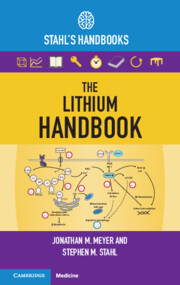Book contents
- The Lithium Handbook
- Reviews
- The Lithium Handbook
- Copyright page
- Contents
- Foreword
- Preface: How to Use This Handbook
- Introduction
- 1 The Efficacy Story
- 2 Renal Handling of Lithium
- 3 Clinical Pharmacokinetics
- 4 Lithium Initiation and Monitoring
- 5 Management of Routine Lithium Related Adverse Effects
- 6 Lithium Toxicity
- 7 Special Populations and Circumstances
- 8 Lithium Discontinuation
- Index
- References
1 - The Efficacy Story
Acute Mania; Rapid Cycling Bipolar Disorder; Bipolar II Disorder and Bipolar Depression; Bipolar Disorder Prophylaxis, Response Predictors; Unipolar Depression; Suicidality; Aggressive or Impulsive Behavior in Child/Adolescent Patients with Conduct Disorder, in Borderline Personality Disorder or in Patients with Intellectual Disability; Neuroprotective Properties; Elevation of Neutrophil Counts; Mechanisms of Action
Published online by Cambridge University Press: 09 February 2024
- The Lithium Handbook
- Reviews
- The Lithium Handbook
- Copyright page
- Contents
- Foreword
- Preface: How to Use This Handbook
- Introduction
- 1 The Efficacy Story
- 2 Renal Handling of Lithium
- 3 Clinical Pharmacokinetics
- 4 Lithium Initiation and Monitoring
- 5 Management of Routine Lithium Related Adverse Effects
- 6 Lithium Toxicity
- 7 Special Populations and Circumstances
- 8 Lithium Discontinuation
- Index
- References
Summary
Acute Mania; Rapid Cycling Bipolar Disorder; Bipolar II Disorder and Bipolar Depression; Bipolar Disorder Prophylaxis, Response Predictors; Unipolar Depression; Suicidality; Aggressive or Impulsive Behavior in Child/Adolescent Patients with Conduct Disorder, in Borderline Personality Disorder or in Patients with Intellectual Disability; Neuroprotective Properties; Elevation of Neutrophil Counts; Mechanisms of Action
- Type
- Chapter
- Information
- The Lithium HandbookStahl's Handbooks, pp. 24 - 94Publisher: Cambridge University PressPrint publication year: 2023



